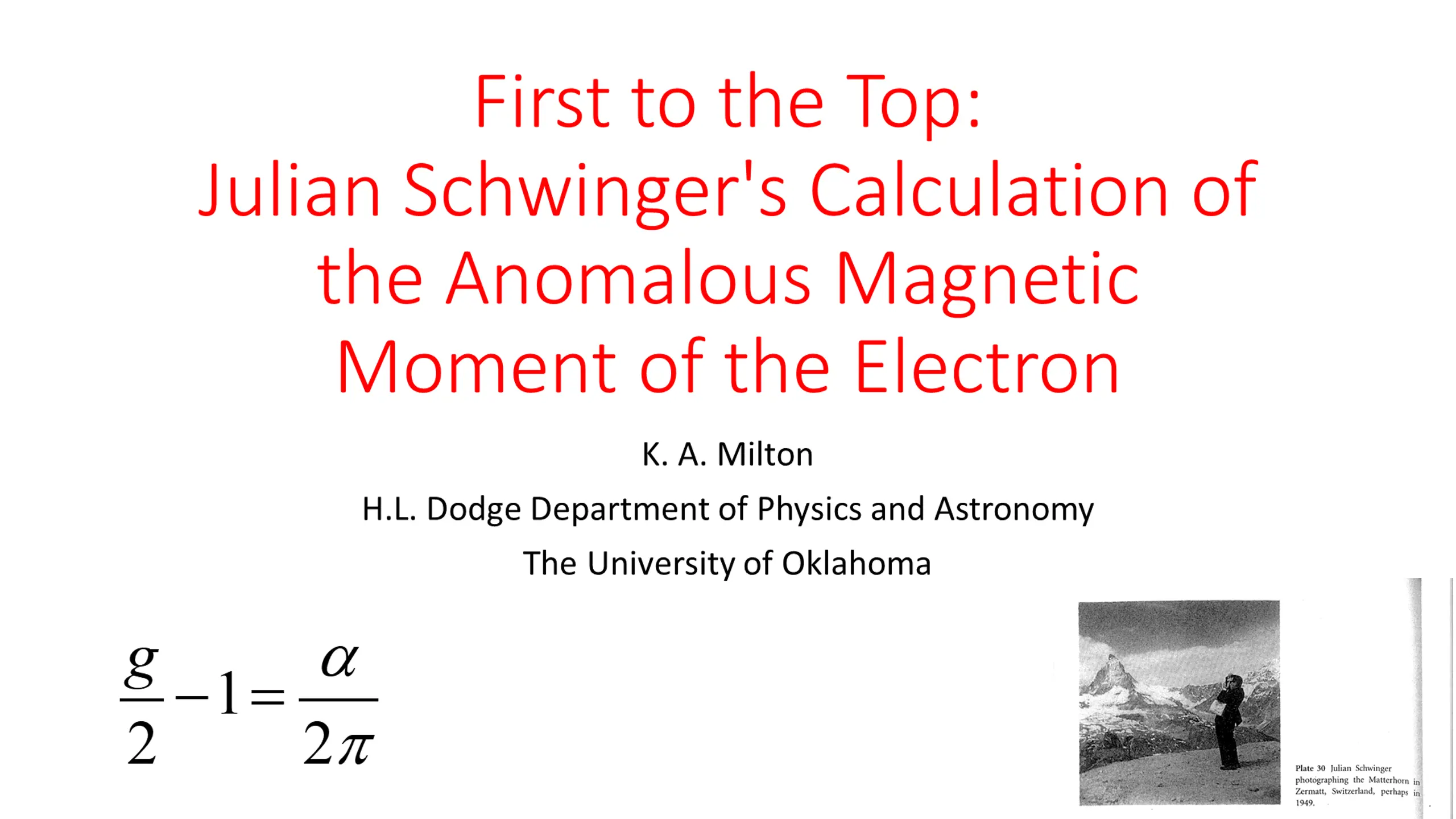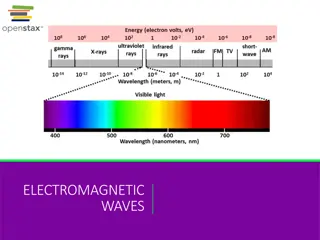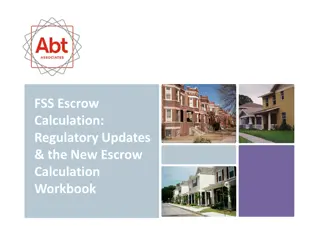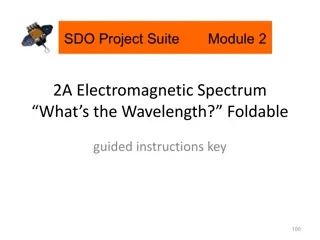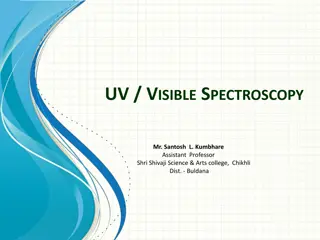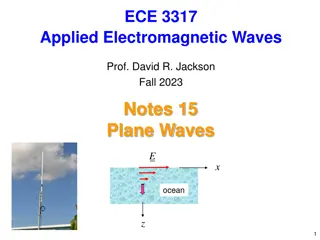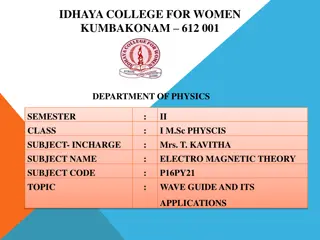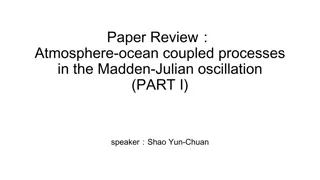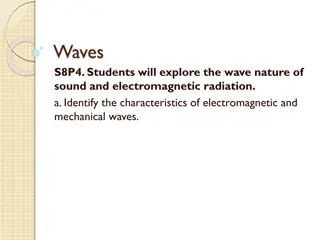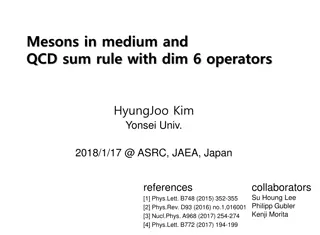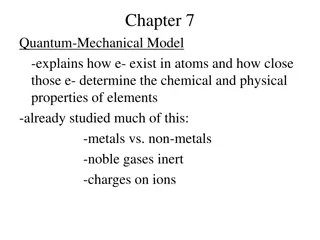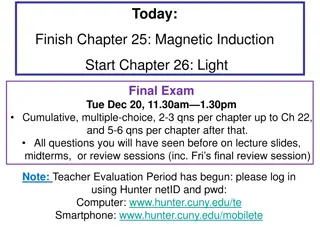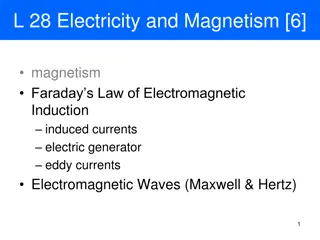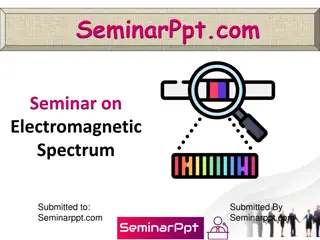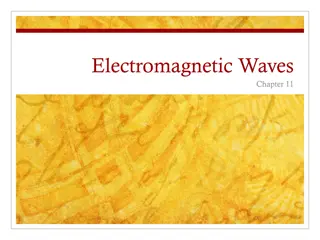Unveiling Julian Schwinger's Electromagnetic Calculation
Discover the groundbreaking calculation by physicist Julian Schwinger on the electron's anomalous magnetic moment. Gain insights into this pivotal contribution in physics research that impacts our understanding of the electron's behavior. This work sheds light on Schwinger's innovative approach and its implications for the field.
Download Presentation

Please find below an Image/Link to download the presentation.
The content on the website is provided AS IS for your information and personal use only. It may not be sold, licensed, or shared on other websites without obtaining consent from the author.If you encounter any issues during the download, it is possible that the publisher has removed the file from their server.
You are allowed to download the files provided on this website for personal or commercial use, subject to the condition that they are used lawfully. All files are the property of their respective owners.
The content on the website is provided AS IS for your information and personal use only. It may not be sold, licensed, or shared on other websites without obtaining consent from the author.
E N D
Presentation Transcript
First to the Top: Julian Schwinger's Calculation of the Anomalous Magnetic Moment of the Electron K. A. Milton H.L. Dodge Department of Physics and Astronomy The University of Oklahoma 2-1=a 2p g
The spin of the electron Goudsmit and Uhlenbeck proposed that the electron had spin- (1925), carrying a magnetic moment of one Bohr magneton, e /2mc. Factor of 2 discrepancy explained by Thomas precession. Robert Kronig can come up with idea before, but was shot down by his advisor Pauli! Thomas: The infallibility of the Deity does not extend to his self- styled vicar on earth. George Uhlenbeck, Hendrik Kramers, Sam Goudsmit, 1928, Ann Arbor. All students of Ehrenfest.
Dirac Equation, 1928 ( p+m) =0 Dirac proposed a first-order equation consistent with relativity to describe the electron: It predicted that the electron had spin S = /2 and had a g-factor of 2. = g S (e/2m) The Dirac theory predicted that the 2s_1/2 and 2p_1/2 levels would be degenerate, since the energies depended on principal quantum number and j, the total angular momentum quantum number.
Early hints that the Dirac equation was incomplete: Millman and Kusch (1940) obtained results for nuclear magnetic moments based on g for the electron being exactly 2, but these nuclear g- factors were consistently 0.12% higher than those found in previous work. Houston, Williams, and Pasternack (1937-38) suggested that the Balmer doublets in H, D, and He+ were split: 2^2 S_1/2 was higher than 2^2 P_1/2 by 0.03 cm. But there was no consensus about these small effects, and they were apparently not taken seriously by the community. Polykarp Kusch Goudsmit and Simon Pasternack
Shelter Island (June 1947) and the Lamb shift and g-2 Lamb, Darrow, Weisskopf, Uhlenbeck, Marshak, Schwinger, Bohm. Seated: Oppenheimer, Pais, Feynman, Feshbach Experiments of Nafe, Nelson, and Rabi; Nagel, Julian, and Zacharias; and of Kusch and Foley established that g 2, and Lamb and Retherford showed that the Pasternack effect existed as the Lamb shift. The latter was known to the participants beforehand, but the former was a surprise.
Hans Bethes nonrelativistic calculation of Lamb shift. Schwinger, Weisskopf, and Oppenheimer had suggested at Shelter Island that the energy displacements were due to the interaction of the electron with the electromagnetic radiation field. Bethe on the train back to Schenectady wrote his famous paper, in which he argued that the cutoff to the logarithmic divergence was the electron mass; the result was about a 1000 Mc shift. Mass and charge renormalization were explicit; however, the finite parts of the self-energy were not covariant. Weisskopf was unhappy: he felt he should have been a co- author on the paper on the ``Pasternack effect.
Relativistic calculations proved more challenging Both Feynman and Schwinger made the same mistake; they failed to correctly patch the relativistic and nonrelativistic parts of the contribution of longitudinal photons. Dyson: Schwinger first detected the incorrect insertion of photon mass. In fact, French and Weisskopf had it right first, but the reputation of Feynman and Schwinger caused a delay in their publication until after that of Kroll and Lamb in 1949. [FW, PR 75, 1240 (1949);KL, PR 75, 388 (1949)] Feynman apologized for this delay in his famous Footnote 13, while Schwinger did not; but in fact, Schwinger never published his results at the time.
After Shelter Island Schwinger returned to Cambridge ill, but this did not delay his marriage to Clarice Carrol. (He stopped smoking because of his illness.) They then took off on a two month road-trip honeymoon to the West Coast. Only on their return did Julian start to seriously think about QED calculations. Feynman, French, Weisskopf, and others concentrated on the Lamb shift, but Julian fixed on the anomaly in the magnetic moment.
Washington Conference, November 1947 Schwinger described his yet uncompleted work on g-2, and on level shifts. Feynman was there and said the meeting was very poor. The only interesting thing was something that Schwinger said at the end of the meeting. He did point out that the discrepancy in the hyperfine structure of hydrogen noted by Rabi can be explained on the same basis as that of electromagnetic self-energy, as can the line shift of Lamb.
On Quantum-ElectrodynamIcs and the Magnetlc Moment of the Electron J. Schwinger, Harvard University, Cambridge, Massachusetts, December 30, 1947 Physical Review 73, 73, 416
As stated in the Letter to the Editor: ``The detailed application of the theory shows that the radiative correction to the magnetic interaction energy corresponds to an additional magnetic moment associated with the electron spin, of magnitude / =( )e^2/ c = 0.001162. It is indeed gratifying that recently acquired experimental data confirm this prediction. Note the misprint: it should be 1/(2 ). Schwinger goes on to compare with the hyperfine splittings seen in hydrogen, deuterium, and most precisely for Na and Ga. He notes that in the process of obtaining these results, mass and charge renormalization must be effected.
Lamb shift and electron scattering He ends the note by remarking that he has calculated the shift of energy levels in hydrogen-like atoms, and the modification of scattering of electrons in a Coulomb field. Agreement with the Lamb-Retherford experiment and with Bethe s calculation is noted, but no results are given: A paper dealing with the details of this theory and its applications is in course of preparation. But before such a paper could be written, Schwinger completely reformulated his theory.
January 1948 New York APS meeting (Columbia) Schwinger reported on his results in Quantum Electrodynamics in a one-hour lecture. The talk was met with such acclaim, but given in such a small room (K.K. Darrow, secretary of the APS, did not have much regard for theory), that it had to be repeated two more times, in successively larger venues. Feynman announced after Schwinger s lecture that he had obtained all the same results, but that he found, unlike Schwinger, that the magnetic moment of an electron in an atom was the same as that of a free electron. (Schwinger had not done a covariant calculation.) There is some doubt Feynman had a complete calculation by that date, but Feynman was right. After the talk, Rabi encountered Victor LaMer in the Faculty Club elevator and started speaking about this sensational revolution. LaMer asked who was the speaker? Rabi: ``Oh, you know him, you gave him an F, Julian Schwinger!
Schwinger had two advantages over Feynman He knew from his work with Oppenheimer at Berkeley that vacuum polarization existed: On pair creation in the proton bombardment of fluorine, PR 56, 1066 (1939). [Feynman initially doubted that loop corrections existed for the photon propagator, since his method did not seem to render them finite.] He had extensively understood relativistic self-energy effects at the classical level from his work on radar and synchrotron radiation at the MIT Radiation Lab during the War, which would give him a head start in dealing with the problems of self-energy in quantum electrodynamics.
Pocono Conference, March 30-April 2, 1948 Schwinger presented in the morning, Feynman in the afternoon. In spite of questions and objections from Bohr, Teller, Dirac, etc., Schwinger proceeded on for hours, saying perhaps it will become clearer if I proceed. The same trick did not work for Feynman. What about the exclusion principle? Feynman: It doesn t make any difference for intermediate states. Teller: It is fundamentally wrong! But afterwards, Schwinger and Feynman compared notes, and although they couldn t understand each other s methods, they always got the same answers, so both knew they were on the right track!
Schwingers lecture Shin inchiro Tomonaga Schwinger presented a covariant approach based on the Tomonaga-Schwinger equation i c ( )/ (x) = H(x) ( ) where (x) is a spacelike surface, and H(x) is the interaction Hamiltonian density. Through a series of canonical transformations, he was able to calculate the Lamb shift and the anomalous magnetic moment of the electron. This was the genesis of his Quantum Electrodynamics series: PR 74, 1439 (1948); 75, 651 (1949); 76, 790 (1949).
Reaction in Chicago Fermi, Teller, and Wentzel went to Pocono; for once Fermi took voluminous notes. After they returned, they met with graduate students, Chew, Goldberger, Rosenbluth, and Yang, and spent 6 weeks trying to digest Fermi s notes of Schwinger s lecture. Yang: afterwards we were all very tired, and none of us felt we had understood what Schwinger had done. We only knew he had done something brilliant. ``Didn t Feynman also talk? All that could be remembered was his strange notation, p with a slash through it.
Michigan Summer School, July-August 1948 Schwinger s lectures, notes of which are extant in the UCLA archives, largely parallel the Quantum Electrodynamics papers. There he gave his (incorrect) result for the Lamb shift: E ~ (Bethe log)-ln 2+3/8-1/5+1/2 where the first term is the Bethe logarithm, -1/5 corresponds to vacuum polarization, and the is the magnetic moment effect, now correctly incorporated. 3/8 should have been 5/6, as French and Weisskopf first found. Schwinger found his error a few months later. That was where he first encountered Dyson, who would go on to explicitly demonstrate the equivalence of Feynman s and Schwinger s approaches.
Gauge Invariance and Vacuum Polarization Before he reformulated QED a third time, Schwinger published his most cited paper, PR 82, 664 (1951). Besides setting forth QED in external electromagnetic fields, including the Schwinger effect, and giving the first clear statement of the axial-vector anomaly (anticipating Adler, Bell, and Jackiw by 2 decades), he gave what he thought was the shortest derivation of the anomalous magnetic moment of the electron in an Appendix. He uses a proper-time method to give a less than one-page derivation of /2 .
The Dynamical Action Principle Schwinger s 3rdreformulation of QFT began before GIVP, in terms of his Quantum Action Principle, the quantum transcription of Hamilton s action principle. This began right after the submission of QED III in May 1949. < , _1| , _2> = (i/ ) < , _1| W_{12}| , _2> in terms of observables defined on spacelike hypersurfaces, _1 and _2. The changes in the action may be either kinematical or dynamical. This principle supplies not only equations of motion, but the commutation relations between the dynamical variables.
The Theory of Quantized Fields A series of five papers bearing this name appeared between 1951 and 1954, PR 82, 914 (1951); 91, 713 (1953); 91, 728 (1953); 92, 1283 (1953); 93, 615 (1954). Even more important were his Green s functions of quantized fields, I,II, PNAS 37, 452, 455 (1951). Paul Martin stated: During this period the religion had its own golden rule---the action principle---and its own cryptic testament--- On the Green s Functions of Quantized Fields. Mastery of this paper conferred on followers a high priest status. The testament was couched in terms that could not be questioned, in a language whose elements were the values of real physical observables and their correlations.
Further comments from High Priest Martin The language was enlightening, but the lectures were exciting because they were more than metaphysical. Along with structural insights, succinct and implicit self-consistent methods for generating true statements were revealed. To be sure, the techniques were perturbative, but they were sufficiently potent to work when power series in the coupling failed because, for example, the coupling was strong enough to produce bound states. The lectures continued through Harvard s reading period and then the examination period. In one course we attended, he presented his last lecture---a novel calculation of the Lamb shift---during Commencement Week. The audience continued coming and he continued lecturing.
Fourth-order correction to g-2 This was calculated first by Robert Karplus and Norman Kroll in 1950; Schwinger used this result in his own work, but suspected it might be erroneous. (Petermann reports there was a discrepancy in the Lamb shift.) Schwinger suggested to his student Charles Sommerfield that he re-do the calculation. Schwinger: Interestingly enough, although Feynman-Dyson methods were applied early [by Karplus and Kroll], the first correct higher- order calculation was done by Sommerfield using [my] methods. Sommerfield, PR 107, 328 (1957); Ann. Phys. (N.Y.) 5, 20 (1958). A. Petermann, Helv. Phys. Acta 30, 407 (1957); Nucl. Phys. 5, 677 (1958).
Schwinger eventually calculated g-2 to 4th order himself He devoted more than 60 pages of the third volume of Particles, Sources, and Fields (written in 1973, published in 1989) to a detailed calculation of the anomalous magnetic moment to 4thorder, now using his 4th reformulation of quantum field theory, source theory. g/2-1 = /(2 )+[197/144+ ^2/12-( ^2/2)ln 2+3 (3)/4]( / )^2+... = /(2 ) - 0.328 ( / )^2+ ... , the second term being almost 10 times smaller than that found by K&K. The latter simply made an arithmetic error, but the heroism of their early calculation should not be minimized. Of course now the 6thorder and 8thorder are known analytically. (Remiddi and Laporta). 10thorder is well estimated by Kinoshita s group.
Discovery of the muon Discovered by Anderson and Neddermeyer in 1937, it was initially identified with Yukawa s mesotron, carrier of the strong force between nucleons. Of course, the interactions were all wrong! Not till 1947 was the pion discovered, and so the muon became just a heavy electron. Rabi: Who ordered that? We still don t know why the world is made of three replicas of the first generation of quarks and leptons. Apparently, all the fundamental properties of the muon and the electron are exactly the same.
Difference between electron and muon g-2 Vacuum polarization is the source of the difference between the g- factors of the electron and muon. In QED these particles differ only by their masses. Vacuum polarization comes in at 4thorder. The calculation is given also in PSF, vol. 2 (1973), although of course it was known much earlier [Suura and Wichmann PR 105, 1930 (1957); Petermann, PR 105, 1931 (1957)]: (g_ -g_e)/2 = ^2/(3 ^2)[ln ( /m)-25/12+3 ^2/4(m/ )] = 0.590 10^{-5} where m and denote the masses of the electron and muon. This accounts for 90% of the difference .
Weak corrections to muon magnetic moment (g/2-1)=G ^2/(8 ^2 2) (10/3 +(4/3)(1-6 W^2/Z^2+4 W^4/Z^4) , W, Z = masses of corresponding particles These were computed as soon as the electroweak synthesis was established: (Schwinger)-Glashow-Weinberg-Salam 1972: Jackiw & Weinberg; Bars & Yoshimura; Bardeen, Gasrmans &Lautrup; Fujikawa, Lee & Sanda 1974: Tsai, DeRaad, Milton recalculated using Schwinger s source theory mass operator approach
Because of its higher mass, VP brings in important hadronic corrections for the muon g-2
Electron and muon anomalous magnetic moments According to PDG: g_e/2-1 = 1.15965218091 (26) 10^{-3} g_ /2-1 = 1.1659209 (6) 10^{-3} The former constitutes the most striking confirmation of QED. For some years after its precision measurement by Gabrielse et al., it could not even be tested against theory, since was not known precisely enough. Now g_e is the most accurate prediction in history, since can be measured using matter-wave interferometry (Cs-133) [Parker et al., Science, 2018]: 1/ = 137.035999046 (27) The anomalous magnetic moment of the muon is in some tension with theory, however, which is the subject of this conference.
Julian Schwingers legacy Schwinger was first to calculate the correction to Dirac s value of the magnetic moment of the electron. Together with all the higher corrections which have been heroically calculated through the years, and equally brilliant experimental work, we now have in QED the most magnificent theory the world has ever known. Neither Feynman nor Schwinger would have thought QED (now the cornerstone of the standard model) would have reigned uncorrected two decades into the 21stcentury. But maybe the muon is hinting at something beyond?
Further Historical Reading Silvan S. Schweber, QED and the Men Who Made It: Dyson, Feynman, Schwinger, and Tomonaga, Princeton University Press, 1994. Jagdesh Mehra and Kimball A. Milton, Climbing the Mountain: The Scientific Biography of Julian Schwinger, Oxford University Press, 2000.
